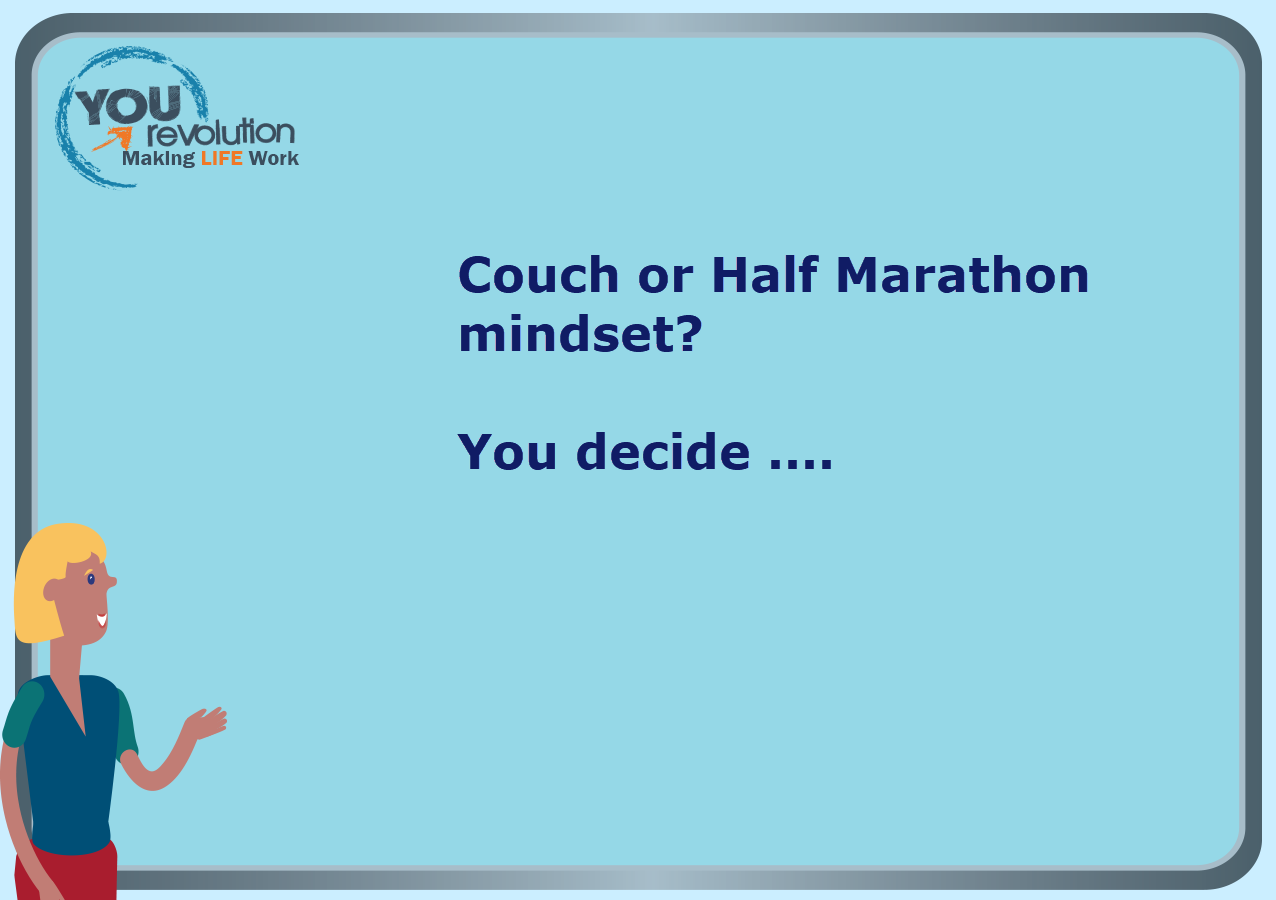Couch or Half Marathon Mindset ? You decide ……
Why is it no matter how much time most people are given, they often finish jobs or tasks at the last minute and are left feeling completely stressed out?
• Why is it that very high wage earners end up broke?
• Why do organisations get stuck firefighting?
• Why do the lonely find it hard to make friends or to find a partner?
• Why do most New Year Resolutions fail by February?
These questions seem unconnected, yet drawing on a raft of research in psychology and behavioural economics, Harvard economist Mullainathan and Princeton psychologist Shafir illustrate that they are all examples of a mind-set produced by scarcity. Put simply, you and most people, often force the brain to focus on alleviating pressing shortages and thus reducing the mental bandwidth available to address other needs such as:
• planning ahead
• exert self-control
• problem solving
The result these academics argue, is a life fixated on agonising trade-offs, crises, and preoccupations that impose persistent negative thinking and self defeating actions.
how can you re programme your scarcity mindset and develop a healthier growth mindset instead?
so that you can get the most out of your half marathon training programme, personal and development or coaching sessions at work or in your personal life?
According to Psychology today, “making resolutions or new habits work is essentially changing behaviors and in order to do that, you have to change your thinking and “rewire” your brain. Brain scientists such as Antonio Damasio and Joseph LeDoux and psychotherapist Stephen Hayes have discovered, through the use of MRIs, that habitual behavior is created by thinking patterns that create neural pathways and memories, which become the default basis for your behavior when you’re faced with a choice or decision. Trying to change that default thinking by “not trying to do it,” in effect just strengthens it. Change requires creating new neural pathways from new thinking.”
Here’s some more Neuroscience research relating to scarcity mindsets which can have a huge impact on your half marathon training, personal development and coaching sessions:
• We recall negative feedback more than we remember praise.
• Unpleasant events tend to be more memorable than pleasant ones.
• The brain is programmed to be vigilant and wary.
• The brain reacts more strongly to negative stimuli than to positive stimuli.
Studies indicate that there’s a greater flow in electrical activity in the brain when we visualise a negative image such as a dead cat than when we witness something positive like a glass of prosecco or yummy lemon cheesecake.
How can Neuroscience and a knowledge of the brain help you to develop a growth mindset, achieve a half marathon run and produce the best return on investment on your coaching sessions?
For those of you who are unfamiliar, Neuroscience is the study of how the nervous system develops, its structure, and what it does. Neuroscientists focus primarily on the brain and its impact on behaviour and cognitive functions.
Neuroscience is an increasingly wide ranging subject. Perhaps because the brain is one of the most complex structures in the known universe:
• intricate enough to coordinate the fingers of a classical violinist
• or logical enough to introduce the laws and theories of gravity.
Now let’s take a brief glimpse at the brain:
The right hemisphere is generally associated with creativity, communicating emotion, analysis of nonverbal information and the control of the left side of the body, temporal and spatial relationships.
Whereas, the left hemisphere is usually identified with logic abilities, casual relationships, sequential thinking, controlling the right side of the body and producing/understanding language and complexities.
The limbic system sometimes referred to as the “emotional brain” is usually considered as composed of the following:
cingulate gyrus, hypothalamus, hippocampus, thalamus and amygdala.
It is the site of: emotional states and behaviour; the bridge between the conscious and subconscious brain and short term memory/ information storage, especially short term recognition of facts, objects, people etc.
The amygdala, the brain’s alarm system is located in the limbic system. Its key function is to call you to attention, and in an emergency, to mobilise or shut-down your body and mind so that you’ll survive.
Sadly though, this alarm rings automatically and unnecessarily often incorrectly informing you that you are experiencing a flight or fight situation when the actual reality is that you are not and the alarm is just being over cautious.
When our amygdala misinterprets a bodily sensation such as sinking stomach to be a message of despair and pessimism, it has exactly the wrong result, reducing rather than enhancing our attention and alertness.
That’s why anxiety, frustration, anger and other chronic stress reactions can occasionally, or for some people frequently, escalate into huge problems.
Put simply, we’re not using our amygdala as effectively as it was intended.
How can you tame your amygdala then?
Having studied this topic for many years now, by far the most comprehensive, informative book about neuroscience and the emotional brain I have read so far is the:
Chimp Paradox by Professor Stephen Peters
As Coach of the Great Britain Cycling and Rowing Teams, and many business leaders, Peters, Author of the Chimp Paradox, developed a highly successful mind management programme using the term “Chimp Brain” as its premise.
The Chimp Brain – Chimp Paradox
Peters asserts that “Chimp Brain” is an emotional part of our brain designed by evolution to support our survival.
Specifically, it is the area of the brain which activates the fight-or-flight response, hyperarousal, hypervigilance or the acute stress response, physiological reactions that occurs in response to a perceived harmful event or threat to our survival.
As it is fundamently concerned with two main instincts:
(i) survival and (ii) procreation
for example: sexual reproduction, hunger, thirst and protection of our territory.
The “Chimp” automatically jumps to opinions in the absence of concrete facts and may be paranoid, periodically resulting in catastrophic and irrational behaviour.
According to Dr Peters, the Chimp works on impressions, perceptions and interpretations, not facts and responds up to fives times faster than our rational brain.
Two other terms are also used by Peters, the Human Brain and the Computer.
The Human Brain – Chimp Paradox
This Peters describes as the rational part of the brain highly effective at considering all the available facts and evidence and subsequently reaching careful and deliberate conclusions using cognition. It’s also where our highest values of humanity reside and it works five times more slowly than the chimp.
The Computer Brain – Chimp Paradox
A storage centre of retained experiences jammed full of automatic habits and responses, some positive, some negative. Above all though, when processing what is happening to us, both our Human and Chimp refer to the computer to seek associations and similar experiences. The Computer operates twenty times faster than our Human and four times faster than the Chimp.
You’re probably asking yourself right now how does all this relate to modifying your scarcity mindset then?
Peters argues that before taking any action, we firstly need to recognise these three powerful structures are continually operating in our mind. Furthermore, if we do not acknowledge this we will be perpetually running to catch up with ourselves.
This reminds of the mindfulness approach:
Though we can’t stop our thoughts, feelings or physical sensations, we can take charge of what happens next. We can consciously step back, pause, breathe and choose to observe our negative thoughts rather than responding to them immediately.
Here’s some chimp paradox and mindfulness tools to help you regulate and tame the Chimp and as a result develop a healthier positive growth mindset:
1. Acknowledge that we as Human beings developed a negativity bias, that is, we evolved to notice and respond more forcibly to the negative, since that helped our ancestors to stay alive. Thousands and thousands of years ago, it was more important for cavemen to escape negative situations than it was to approach opportunity.
In other words, our ancestors wouldn’t even have stopped to analyse the situation. As soon as they noticed the slight rustle, like animals of prey, our ancestors would have simply fled for their lifes.
2. As it’s your “Chimp” it will respond sometimes when you are angry, stressed or perceive any kind of threat, physical or psychological, and it moves much more quickly than the Human part of your brain so is likely embarrass you with its responses. It might shout and rage, be rude and angry or violent.
3. Observe Chimp-like responses, these are easy to spot, they are responses which when you reflect later aren’t ones you’re proud of. They are likely the ones that if you had your time again you’d do differently, or they are the responses that you might, with the benefit of hindsight, think you need to apologise for.
4. Be aware that everyone has a Chimp and managing it is an everyday challenge, when we’re tired or stressed our Chimp becomes more difficult to control and can overwhelm us more easily. Observe other people’s responses, you can see Chimp behaviour everywhere.
5. Having become aware of your Chimp, you can work on taming it and rather than ignoring the Chimp’s instinctive and rapid reaction, just allow it to have its say. Then, consciously step back, pause, breathe and allow yourself more thinking time to work out a better, more considered Human response.
6. We can use the Computer part of our brain, our automated habits, to put in responses faster than the Chimp can react. This takes time and practice, but if we make a conscious effort to put in a different response to the impulsive Chimp one, we can develop what Peters calls an Autopilot, which is a script or response that overrides the unhelpful Chimp response before it can be enacted.
This chimp paradox approach is very similar to Mindfulness strategies I offer clients during coaching sessions:
When you experience a negative thought, feeling or physical sensation, breathe, pause, step back then ask yourself the following question:
“what do I know?”
“I know that if I allow my negative thoughts to take over it is not healthy for me and leaves me feeling anxious, I also know that though I can’t stop my thoughts, feelings or physical sensations, I can change what happens next, such as, consciously deciding to stop myself from catastrophising or getting too attached to my thoughts.”
“I know that thoughts aren’t facts”
Following your attempts at implementing the above strategy, record on a piece of paper the process of what happens when you try this technique and the automatic negative thoughts that stop you from supporting yourself.
Now, let’s take a real life example of a person wanting to create their dream goals or ideal life:
Instead of focusing on scarcity and deprivation by talking yourself out of it by getting into a negative thinking style of what ifs, buts, shoulds etc, ie scarcity, approach your dream goal or ideal life by placing yourself in a growth mindset:
Here’s how:
(1) firstly, create your own goals or life script by writing down one or a series of positive affirmations on a piece of paper or on your tablet such as:
“I’m really happy and grateful that it’s the 25th August and I’m enjoying running the Severn Bridge Half Marathon race especially collecting my medal at the finishing line”.
or I’m really happy and grateful for all the following things that I’m just about to say:
I’m really happy and grateful to be a wildly successful writer and public speaker, and wife with an endless regular weekly supply of income that greatly exceeds my outgoings.
What’s also wonderful is that my work is mostly daytime and online so I can do it anywhere in the world.
I have over 5,000 twitter and instagram followers and I’m thrilled that my fiction book is a best seller.
I have great health and I’m really enjoying a good work life balance with lots of time to relax and exercise to play piano and make jewellery and other creative activities.
My life is full of fun and joy and I have an abundance of male and female friends that bring out the best in me in Wiltshire and in other parts of the UK .
And I’m open to receiving this and more thank you.”
repeat this at least once each morning and then just before you go to sleep for at least a six week period.
(tip: ensure all statements are in the present tense as if they are happening right now and avoid using words such as not, never, no longer etc)
(2) then, cut out some images/photos from either a magazine or the internet relating to your life script and arrange them on a piece of paper or on a cork memo board/whiteboard. Alternatively, create a collage by using pinterest or instagram.
What is key here is to look at the relevant image/photo whilst you are reading each affirmation out loud (ideally smiling and with heaps of enthusiasm and belief!)
(3) Be mindful. Become physically, emotionally and mentally aware of your inner state as each external event happens, moment by moment, rather than living in the past or future
(4) Last but not least, reflect on this statement: you never fail if you never give up
In other words, it’s about moderation not deprivation and adopting a small steps approach such as and be patient…
Sounds simple and perhaps mumbo jumbo doesn’t it? However, I have used this technique with several clients and friends to help them tackle issues such as:
• overcoming procrastination
• overcoming addictions
• overcoming shyness and social phobia
• overcoming anxiety and exhaustion
• overcoming loneliness
The results have often been astounding. Having said that though, most of these clients have undertaken a few counselling or coaching sessions with me, Karen Deeming, before adopting the above exercise in order to achieve their goals.
What’s the primary principle behind this techique?
The subconscious mind operates 95% of your life and only 5% of what you are thinking or perceiving is your conscious mind.
The subconscious mind works most effectively with pictures and imagery so you want to take advantage of that, ie the photos. Once you train your subconscious mind to focus on the things that you want then your performance starts to follow because your performance is always aligned with your subconscious mind.
Also as children we picked up messages from parents, peers, teachers and society, not always positive, that literally form the 95% that we are not conscious of and this 95% is really running the show often resulting in fears and doubts that cause us to procrastinate or to feel stuck and demotivated.
For example:
• don’t dream like this
• you can never have this kind of house
• don’t set yourself up for failure
• you can never run your own business it’s too risky
We then blame our doubts and fears on the external world and we play the victim but the reality is it is our own selfs we are our own saboteurs.
The creating your dream goal or ideal life exercise is an ideal tool to reprogramme your subconscious and of course your unhealthy, scarcity mindset.
Does any of this sound familiar? What can you do about it?
Be honest with yourself and acknowledge that you’ve probably fallen victim to the scarcity trap and mind set. Naturally, the reason will be different for each person and remember you’re not alone in this very common dilemma…
Take control of your negative internal chatter box alias “inner critic”.
Over to you:
If after reading this blog, you are still struggling to overcome your scarcity mindset and are feeling overwhelmed with distractions and negative thoughts don’t panic or give up just yet.
Coaching, counselling or a personal development or mindfulness course can help you.
I’ll end with a few growth mindset insights that have helped me, Karen Deeming, along the way:
• whatever is going on in your mind is what you are attracting
• happy feelings will attract more happy circumstances
• visualise and rehearse your own future
• shift your awareness
• counselling and coaching is about personal growth and development and encouraging people to discover their potential for living as well as for people with anxiety, depression, stress, bereavement, low self esteem, and relationship difficulties.




